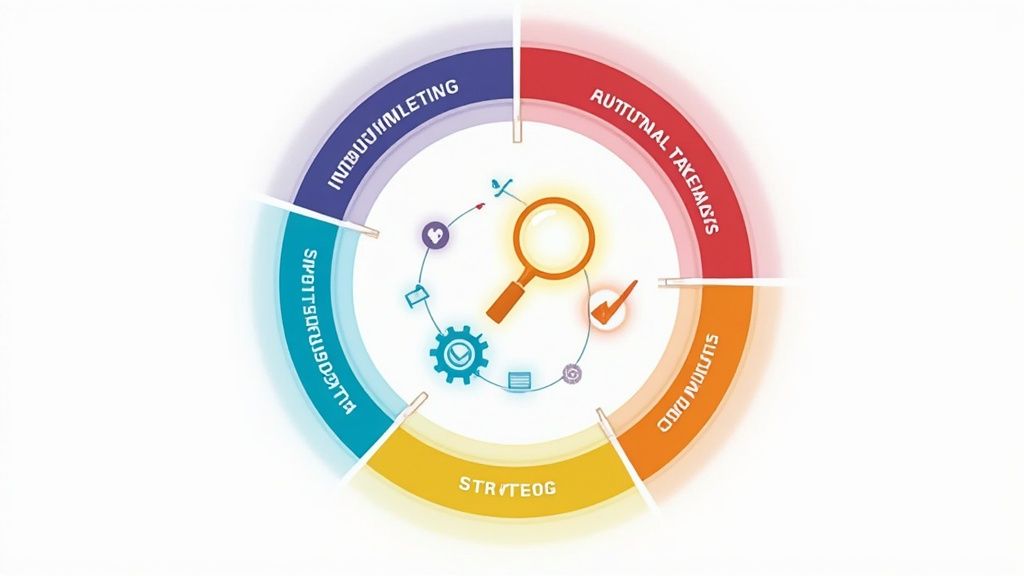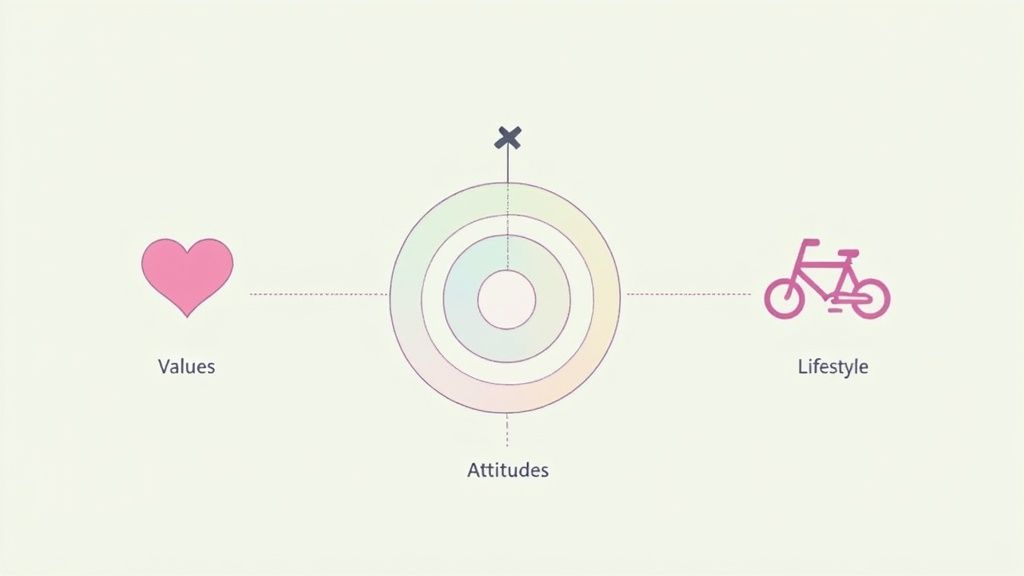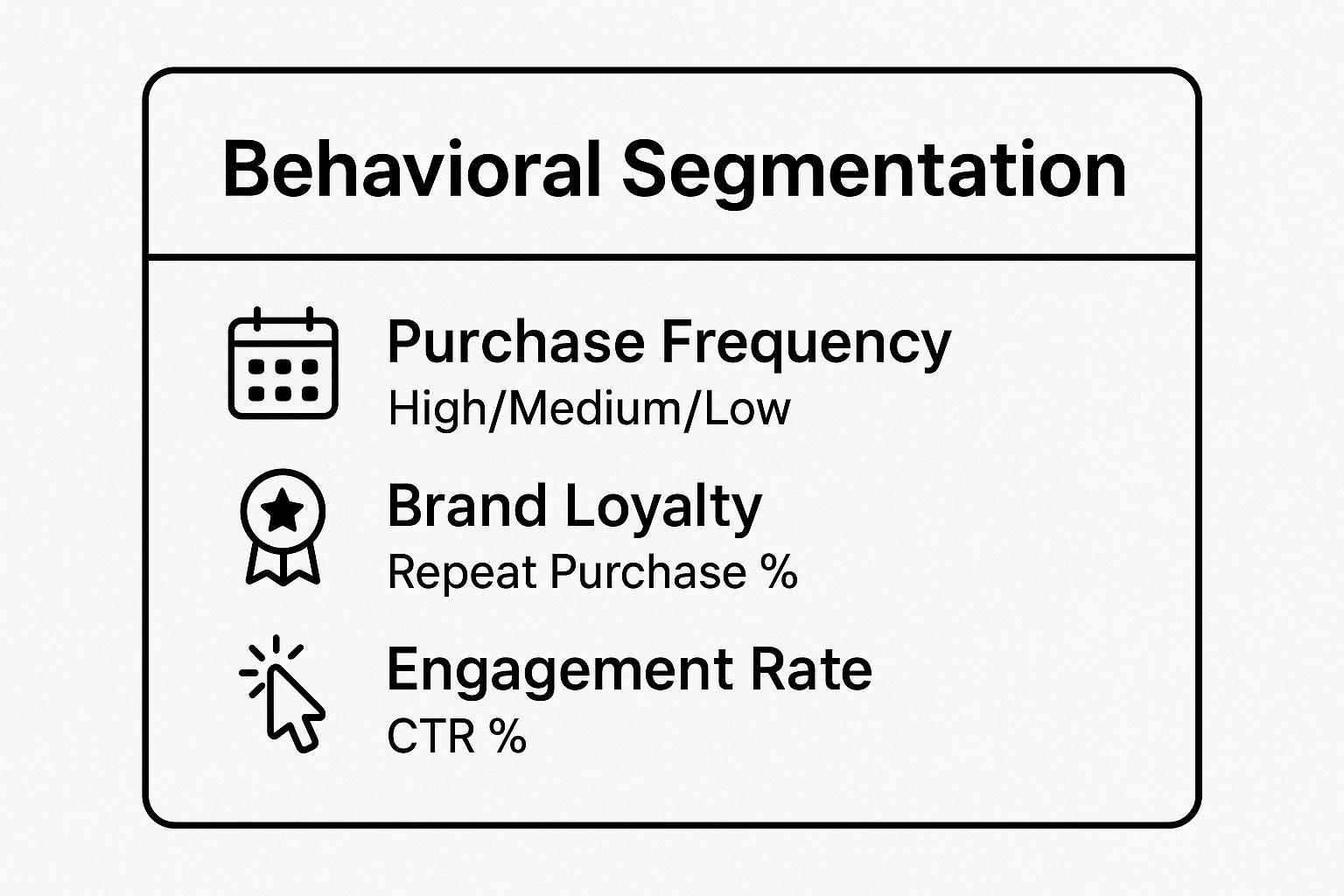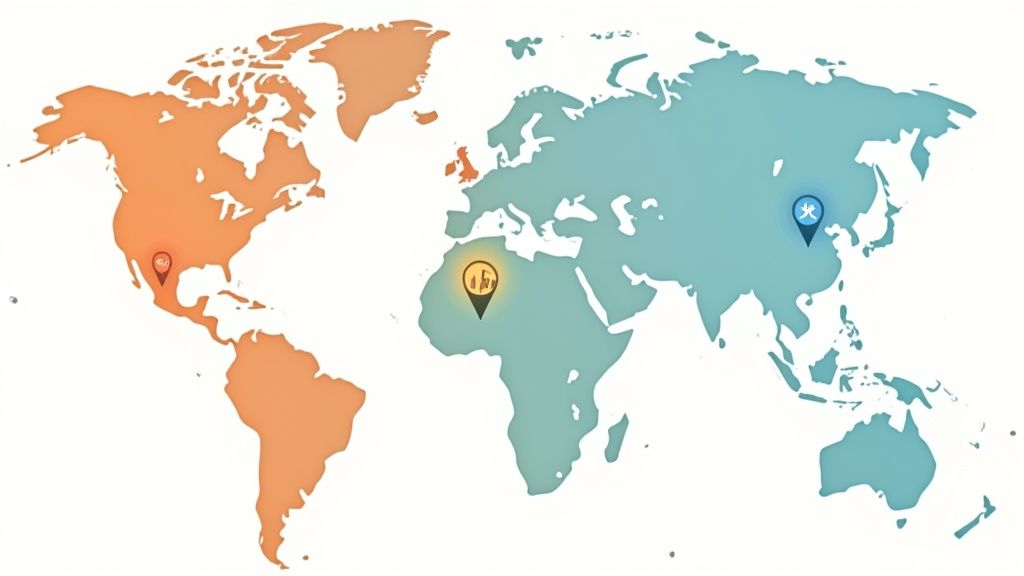
Top 8 Audience Segmentation Examples for 2025 Success
Published
In today's crowded market, speaking to everyone means connecting with no one. Effective marketing isn't about casting the widest net; it’s about delivering the right message to the right person at the right time. This is where audience segmentation, the practice of dividing a broad target market into smaller, more manageable groups based on common needs or characteristics, becomes indispensable. To truly unlock this superpower, it's essential to first understand your audience by gaining deeper marketing consumer insights.
By understanding the specific nuances between different customer groups, you can tailor your influencer marketing campaigns, personalize messaging, and optimize ad spend for maximum impact. Moving beyond generic outreach allows you to build deeper connections, boost engagement, and drive meaningful conversions. These targeted approaches ensure your efforts resonate, turning passive viewers into loyal advocates.
This guide moves past theory and dives straight into practical application. We will explore eight crucial audience segmentation examples, breaking down real-world digital campaigns from leading brands. Each example includes a deep strategic analysis, specific tactical insights, and actionable takeaways you can replicate. Prepare to learn how to craft more precise and powerful marketing strategies for 2025 and beyond.
1. Demographic Segmentation
Demographic segmentation is one of the most foundational and widely used audience segmentation examples. This method involves dividing a broad market into smaller, more manageable groups based on quantifiable population characteristics. These variables include age, gender, income, education level, occupation, and family status. The power of this approach lies in its simplicity and the relative ease of data collection, providing a clear and direct path to more targeted marketing campaigns.

For a more detailed explanation of how this fundamental approach works, refer to our comprehensive guide on Demographic Segmentation in Marketing. It offers a deeper dive into the mechanics and strategic applications of this essential marketing practice.
Strategic Breakdown & Example: Nike
Nike is a master of demographic segmentation, creating distinct product lines and marketing messages for different age groups.
- For Kids (Ages 5-12): Nike focuses on fun, play, and inspiration. Influencer collaborations often feature young athletes or family-focused creators who emphasize durability and comfort for active children.
- For Teens (Ages 13-19): Marketing shifts to style, social trends, and athletic aspiration. They partner with Gen Z influencers on platforms like TikTok and Instagram to showcase how Nike gear fits into their daily lives and personal expression.
- For Young Adults (Ages 20-35): The message centers on performance, fitness goals, and lifestyle integration. Campaigns feature professional athletes and fitness influencers who provide training tips and motivation.
- For Older Adults (Ages 40+): Nike targets this segment with messaging around wellness, sustained activity, and comfort for activities like walking, yoga, and golf.
Actionable Takeaways
To effectively implement demographic segmentation, brands and influencer marketers should:
- Combine Variables: Don't just target "women." Instead, target "women aged 25-34 with an annual income over $75,000 and an interest in sustainable living." This creates a much more refined and effective persona.
- Update Data Regularly: Populations and their characteristics change. A neighborhood that was primarily young renters five years ago might now be dominated by young families. Regularly refresh your demographic data to stay relevant.
- Use as a Foundation: Demographic data provides the "who," but it doesn't always explain the "why." Use it as a starting point and layer it with psychographic or behavioral data for a complete picture of your audience.
2. Psychographic Segmentation
Psychographic segmentation moves beyond the "who" (demographics) to understand the "why" behind consumer actions. This powerful audience segmentation example categorizes people based on their psychological attributes, such as lifestyle, values, attitudes, interests, and personality traits. By focusing on what motivates an audience, this method allows brands to craft messages that resonate on a deeper, more personal level, fostering stronger connections and brand loyalty.

This approach is particularly effective in crowded markets where emotional connection and shared values are key differentiators. For a deeper understanding of this method, explore how frameworks like VALS (Values and Lifestyles) provide structured ways to apply these insights in your marketing strategies.
Strategic Breakdown & Example: Patagonia
Patagonia is a prime example of a brand built on psychographic segmentation, targeting a niche audience that values more than just high-performance outdoor gear.
- The "Outdoor Activist" (Core Psychographic): Patagonia doesn't just target hikers; it targets individuals who see nature as something to be protected. This segment values sustainability, environmental activism, minimalism, and durability over fast fashion.
- Value-Driven Messaging: Campaigns like "Don't Buy This Jacket" directly appeal to the anti-consumerist and pro-environmental attitudes of their core audience. This counterintuitive message reinforces brand authenticity and builds immense trust.
- Influencer & Ambassador Alignment: They partner not with the flashiest athletes, but with environmental scientists, activists, and dirtbag climbers whose lifestyles and values mirror the brand's ethos. This creates authentic, mission-driven content that resonates deeply.
- Product Storytelling: Every product is framed around its environmental impact and longevity, appealing to the segment's desire for responsible consumption.
Actionable Takeaways
To effectively implement psychographic segmentation, brands and influencer marketers should:
- Analyze Social Media Engagement: Look beyond likes and comments. Analyze the language, values, and interests expressed by your most engaged followers. What other accounts do they follow? What causes do they support?
- Develop Value-Centric Personas: Create detailed customer personas that include their core beliefs, aspirations, and pain points. Go beyond "Loves hiking" to "Believes in preserving wild spaces for future generations."
- Align Messaging with Values: Craft campaigns and influencer briefs that speak directly to these core values. If your audience values authenticity, avoid overly polished or sales-heavy content.
- Use Surveys to Uncover Motivations: Deploy surveys with questions designed to reveal attitudes and lifestyles. Ask about hobbies, priorities, and opinions on social issues to gather rich psychographic data.
3. Behavioral Segmentation
Behavioral segmentation moves beyond who your audience is to focus on what they do. This powerful method divides markets based on observable actions and interactions with a brand. These actions include purchase history, product usage rates, brand loyalty, and engagement with marketing content. Because it is rooted in actual user data rather than self-reported traits, it is one of the most predictive and effective audience segmentation examples for driving conversions and retention.
The infographic below highlights key metrics used in this type of segmentation.

Tracking metrics like purchase frequency, loyalty, and engagement allows brands to create highly relevant and timely marketing triggers that resonate with specific user actions.
Strategic Breakdown & Example: Amazon
Amazon is a pioneer and a master of behavioral segmentation, building its entire recommendation engine and marketing ecosystem around user actions.
- Purchase History: If a user buys a coffee machine, Amazon's algorithm immediately segments them into a group likely interested in coffee beans, filters, and mugs. Subsequent marketing emails and on-site recommendations will feature these complementary products.
- Browsing Behavior: A user who browses for running shoes but doesn't buy is placed into a "high-intent" segment. Amazon will retarget them with ads for those specific shoes on other websites and may send a follow-up email highlighting customer reviews or a limited-time offer.
- Usage Rate (Prime Video): Amazon tracks what genres you watch, how long you watch, and which actors you follow. This data fuels personalized "Recommended for You" carousels, ensuring users stay engaged with the platform by always having relevant content to discover.
Actionable Takeaways
To effectively implement behavioral segmentation, influencer marketers and brands should:
- Focus on High-Value Actions: Don't just track every click. Identify key behaviors that correlate directly with business goals, such as adding an item to a cart, completing a video tutorial, or repeatedly purchasing the same product.
- Automate Triggers: Use marketing automation tools to create "if-then" scenarios. For example, if a user abandons their cart, then automatically send them a reminder email with an influencer's product testimonial 24 hours later.
- Combine with Other Segments: Layer behavioral data on top of demographic or psychographic profiles for maximum impact. Target "eco-conscious millennials (psychographic) in urban areas (geographic) who have previously purchased sustainable products (behavioral)" for an incredibly precise campaign.
4. Geographic Segmentation
Geographic segmentation divides a market based on location, such as country, state, city, climate, or population density. This strategy operates on the principle that consumer needs, preferences, and cultural norms can differ vastly from one place to another. By tailoring marketing efforts to specific regions, brands can create more relevant and impactful campaigns that resonate with local audiences, accounting for regional tastes, weather patterns, and cultural nuances.

This method is one of the most powerful audience segmentation examples for global brands or companies with a presence in diverse areas. For a closer look at how local insights can drive global strategy, consider the approach used by industry giants like McDonald's, which has perfected menu localization worldwide.
Strategic Breakdown & Example: McDonald's
McDonald's is a prime example of geographic segmentation, masterfully adapting its menu and marketing to cater to local palates and cultural preferences across the globe.
- India: To respect local religious beliefs where a large portion of the population does not eat beef or pork, McDonald's offers a menu with no beef products. Instead, they feature items like the McSpicy Paneer and the Maharaja Mac (made with chicken).
- Japan: The menu includes unique items that appeal to local tastes, such as the Teriyaki McBurger, Ebi Filet-O (shrimp patty), and seasonal offerings like the Tsukimi "moon viewing" Burger.
- Canada: In Quebec, McDonald's offers poutine, a beloved local dish of french fries, cheese curds, and gravy, demonstrating a deep understanding of regional culinary identity.
- United States: Even within the U.S., there are regional specials. The McLobster roll appears seasonally in New England states, catering to a specific local seafood tradition.
Actionable Takeaways
To leverage geographic segmentation effectively, marketers and brands should:
- Adapt to Local Culture: Don't just translate your message; localize it. Research local customs, holidays, and values. Influencer partnerships should feature creators who are authentic to that specific region.
- Consider Climate and Environment: A retailer promoting heavy winter coats in Miami is wasting resources. Use geographic data to align product promotions with local weather, seasons, and environmental conditions.
- Go Hyper-Local: Modern technology allows for targeting at the zip code or even neighborhood level. Use location-based ads to drive foot traffic to physical stores or promote local events and special offers relevant to a specific community.
5. Firmographic Segmentation (B2B)
Firmographic segmentation is the business-to-business (B2B) equivalent of demographic segmentation. This method involves dividing a business market into smaller groups based on specific company characteristics like industry, annual revenue, company size, number of employees, and geographic location. For B2B companies, this is one of the most crucial audience segmentation examples because it allows them to identify and target organizations that are the best fit for their products or services, leading to more precise and efficient marketing and sales cycles.
Strategic Breakdown & Example: Salesforce
Salesforce, a leader in CRM technology, exemplifies expert firmographic segmentation by tailoring its product suite and marketing strategies to different business scales.
- For Small Businesses (1-100 employees): Salesforce offers "Salesforce Essentials," a streamlined, affordable CRM designed for small teams. Marketing for this segment focuses on ease of use, quick setup, and scalability. Influencer partnerships might involve small business consultants or tech reviewers who highlight how the tool helps a small company grow.
- For Mid-Sized Businesses (100-1,000 employees): The messaging shifts to customization, integration capabilities, and departmental alignment. They offer more robust editions of their Sales Cloud and Service Cloud, and marketing content often features case studies from similar-sized companies that have successfully scaled.
- For Enterprise Corporations (1,000+ employees): Salesforce targets this segment with its most comprehensive and powerful solutions, emphasizing enterprise-grade security, global scalability, and industry-specific platforms (e.g., Financial Services Cloud, Health Cloud). Marketing involves high-level executive events, detailed white papers, and direct sales engagements.
Actionable Takeaways
To effectively implement firmographic segmentation in a B2B context, brands and marketers should:
- Combine with Technographics: Don't just target by company size. Target companies of a certain size within a specific industry that are currently using a competitor's software or lack a specific technology solution. This creates a highly motivated target segment.
- Align Sales and Marketing: Ensure both teams agree on the definitions of key firmographic segments (e.g., what constitutes an "enterprise" vs. a "mid-market" company). This alignment ensures a seamless customer journey from marketing lead to sales-qualified lead.
- Customize Content by Industry: Create content that speaks directly to the unique pain points of each industry vertical. An ebook for a manufacturing company should address supply chain challenges, while one for a financial services firm should focus on compliance and customer data security.
6. Technographic Segmentation
Technographic segmentation categorizes audiences based on their technology adoption patterns, usage preferences, and digital behavior. This method involves dividing a market based on the hardware, software, platforms, and devices consumers use. Variables include device type (mobile vs. desktop), preferred social media channels, software proficiency, and early adopter tendencies. In our hyper-digital world, understanding a consumer's tech stack is crucial, making this one of the most relevant audience segmentation examples for tech companies, B2B marketers, and digital-first brands.
Strategic Breakdown & Example: Adobe
Adobe is a prime example of a company that excels at technographic segmentation, specifically by understanding the tools and workflows of creative professionals. They don't just sell software; they sell an integrated ecosystem tailored to specific creative needs.
- For Photographers & Photo Editors: Adobe targets users of high-end DSLR cameras and powerful editing PCs or Macs. Their marketing for Lightroom and Photoshop emphasizes RAW file processing, advanced color grading, and integration with camera-specific plugins. Influencer collaborations feature professional photographers who showcase their editing workflows.
- For Video Editors & Filmmakers: This segment is identified by their use of 4K+ cameras, high-performance video editing workstations, and large storage solutions. Marketing for Premiere Pro and After Effects focuses on multi-track editing, visual effects capabilities, and seamless rendering.
- For Graphic Designers & Illustrators: Adobe targets users of drawing tablets (like Wacom) and vector-based software. Campaigns for Illustrator and Fresco highlight features like vector manipulation, digital painting, and cross-device syncing between iPad and desktop.
Actionable Takeaways
To effectively implement technographic segmentation, marketers and brands should:
- Analyze Your Website Analytics: Use tools like Google Analytics to understand what devices (mobile, desktop, tablet) and operating systems (iOS, Android, Windows, macOS) your audience uses to access your content. Optimize your user experience for the dominant platforms.
- Segment by Platform Engagement: Don't treat all social media users the same. Segment your audience based on their primary platform. An influencer strategy for a TikTok-native audience will be vastly different from one targeting a LinkedIn-focused professional group.
- Identify Early Adopters: Create segments for users who are first to try new features or products. This group can be a valuable source of feedback and can act as brand evangelists for new technology launches, helping you build momentum.
7. Value-Based Segmentation
Value-based segmentation groups customers according to their economic value to a business. This is a highly strategic approach that moves beyond simple demographics to rank audiences based on their financial contribution, typically measured by Customer Lifetime Value (CLV), profitability, purchase frequency, and average order value. The goal is to identify and nurture your most profitable customers, allowing for efficient resource allocation and maximizing return on investment. It's a powerful way to ensure marketing efforts are focused where they will have the most significant bottom-line impact.
This method is a cornerstone for creating sustainable growth and is one of the most effective audience segmentation examples for businesses with established customer bases. It helps brands understand who their VIPs are and what makes them so valuable.
Strategic Breakdown & Example: Amazon Prime
Amazon masterfully uses value-based segmentation to fuel its Prime membership program. By analyzing purchase history, frequency, and order values, Amazon identifies customers with high CLV potential and targets them for its subscription service.
- High-Value Segment (Frequent, High-Spenders): These customers are the prime candidates for Amazon Prime. The marketing message focuses on convenience, savings on shipping, and exclusive access to deals (like Prime Day) and entertainment. The value proposition is clear: the membership fee is easily offset by the benefits they will receive.
- Mid-Value Segment (Occasional Shoppers): For this group, Amazon might use targeted promotions or free trials to demonstrate the value of Prime. The goal is to increase their purchase frequency and move them into the high-value tier.
- Low-Value Segment (Infrequent Shoppers): While not the primary focus for Prime marketing, Amazon still nurtures this group with standard promotions and recommendations, aiming to gradually increase their engagement and spending over time.
Actionable Takeaways
To effectively implement value-based segmentation for your influencer or digital marketing campaigns, you should:
- Calculate Customer Lifetime Value (CLV): Use your sales data to identify your most profitable customer segments. This requires analyzing historical purchase data and creating predictive models to forecast future value.
- Create Tiered Service Levels: Develop different experiences for different value segments. Your highest-value customers could receive exclusive access to influencer-led events, early product releases, or personalized support, while lower-value segments might receive standard email campaigns.
- Identify Value Drivers: Analyze what moves a customer from a lower to a higher-value segment. Is it a specific product purchase, engagement with a particular type of content, or participation in a loyalty program? Use these insights to create campaigns that encourage this upward migration.
8. Life Stage/Journey-Based Segmentation
Life stage segmentation organizes audiences based on their current position in major life transitions, such as becoming a new parent, starting a career, buying a first home, or entering retirement. This powerful method recognizes that a person's priorities, purchasing power, and needs change dramatically during these pivotal moments. By aligning marketing efforts with these life stages, brands can deliver exceptionally relevant and timely messages. This is one of the more sophisticated audience segmentation examples because it moves beyond static traits to address dynamic life journeys.
This approach is highly effective because it allows brands to anticipate needs. A couple expecting their first child will suddenly be interested in a whole new category of products, from cribs to car seats. Similarly, someone approaching retirement will have different financial concerns than a recent college graduate. Targeting based on these stages makes marketing feel less like an advertisement and more like a helpful guide.
Strategic Breakdown & Example: Target
Target is legendary for its use of life stage segmentation, most famously through its pregnancy prediction model. By analyzing purchasing data, the retailer can identify shoppers who are likely expecting a baby and proactively send them relevant coupons and offers.
- Expecting Parents: Target’s system flags customers buying items like unscented lotion, specific supplements, and larger cotton balls. This triggers a marketing automation workflow that sends baby-related promotions, positioning Target as an essential resource for new families.
- College Students: Around late summer, Target creates "dorm-life" sections in stores and runs digital campaigns targeting first-year college students. Marketing focuses on dorm essentials, study supplies, and easy meal solutions, directly addressing the needs of this transitional phase.
- First-Time Homeowners: This segment receives offers for furniture, home decor, cleaning supplies, and kitchenware. The messaging focuses on setting up a new home and making it their own, tapping into the excitement and needs of this significant financial and personal milestone.
Actionable Takeaways
To effectively implement life stage segmentation, marketers should:
- Identify Key Triggers: Use data to pinpoint behaviors or purchases that signal a life stage transition. This could be a user updating their job title on LinkedIn (career change) or browsing for engagement rings online (impending marriage).
- Develop Stage-Specific Content: Create content that speaks directly to the challenges and opportunities of each life stage. For new parents, this could be influencer content featuring parenting hacks. For retirees, it could be content about travel or new hobbies.
- Respect Privacy: While using data is powerful, be transparent and respectful. Avoid being overly intrusive, which can come across as creepy. Allow users to opt-out or manage their preferences, and gather information through voluntary means like surveys when possible.
8 Key Audience Segmentation Types Compared
| Segmentation Type | ⭐ Expected Outcomes | 🔄 Implementation Complexity | ⚡ Resource Requirements | 💡 Ideal Use Cases | 📊 Key Advantages |
|---|---|---|---|---|---|
| Demographic Segmentation | Clear actionable insights, good predictive power for many products | Low - data is easy to collect and analyze | Low - widely available census and surveys | Media planning, targeting based on age, income, family status | Simple, cost-effective, easy communication |
| Psychographic Segmentation | Deep understanding of motivations, better personalization | High - requires sophisticated research | High - surveys, focus groups, social media analysis | Brand differentiation, lifestyle and luxury marketing | Emotional connection, predicts future behavior |
| Behavioral Segmentation | Highly predictive, real-time personalization | High - needs advanced data collection & analytics | High - continuous data tracking systems | Digital marketing, retargeting, loyalty programs | Data-driven, tied directly to ROI |
| Geographic Segmentation | Effective local targeting, respects regional differences | Low - based on physical location data | Low - location data and mapping tools | Local/regional marketing, climate or culture-specific offers | Easy to implement, supports logistics planning |
| Firmographic Segmentation | Strong predictor of B2B needs & buying power | Medium - requires business data gathering | Medium - business databases & CRM | B2B marketing, account prioritization | Enables efficient sales targeting |
| Technographic Segmentation | Precise digital targeting and prediction of tech adoption | Medium - needs tracking of devices & software | Medium to High - rapidly changing tech data | Tech products marketing, digital campaign optimization | Relevant for digital-first strategies |
| Value-Based Segmentation | Direct link to profitability and ROI | High - involves complex data analysis | High - customer data and analytics tools | Loyalty programs, pricing strategies, resource allocation | Focuses on high-value customers |
| Life Stage/Journey-Based Segmentation | Predictive of immediate needs, timely messaging | Medium - tracking life events is complex | Medium - customer data & predictive analytics | Career, family, financial milestone targeting | Creates emotional resonance, effective upselling |
Putting Segmentation to Work: Building Your Action Plan
We've explored a wide array of powerful audience segmentation examples, moving far beyond basic demographics to unlock deeper, more meaningful connections with consumers. From the values-driven approach of psychographics to the hyper-specific targeting of technographics, the core lesson is clear: one-size-fits-all marketing is no longer effective. The brands succeeding today are those that invest the time to truly understand the distinct needs, behaviors, and motivations of their various audience groups.
The journey from raw data to strategic insight doesn't have to be overwhelming. The key is to start with a focused, manageable approach and build from there. By layering different segmentation models, you create a multi-dimensional view of your customer that transforms generic campaigns into resonant, personalized experiences.
Your Actionable Segmentation Roadmap
Getting started is often the biggest hurdle. Use this simple, three-step framework to translate the concepts we've discussed into a concrete action plan for your next campaign.
Start with a Hybrid Model: Don't try to implement all eight segmentation types at once. Begin by combining foundational demographic data (like age and gender) with a more nuanced layer, such as psychographic (values, interests) or behavioral (past purchase history, engagement level) data. This creates a solid, initial set of personas that are immediately more insightful than a single broad audience.
Guide Your Creative and Influencer Strategy: Use these new, richer personas to guide every decision. Who are the right influencers to reach your "eco-conscious millennial" segment? What messaging will resonate with your "tech-savvy early adopter" group? Your segments become the strategic filter for your content creation, platform selection, and influencer partnerships. Once you have clear segments, the next step is to tailor your messaging. For instance, you can discover 5 powerful ways to personalize video content to speak directly to the unique interests of each audience group.
Test, Measure, and Refine: Audience segmentation is not a "set it and forget it" task. Launch your campaigns, then meticulously track the performance of each segment. Which group had the highest engagement rate? Which segment drove the most conversions? Use this performance data to continuously refine your personas, adjust your messaging, and reallocate your budget to the most responsive audiences.
The Career-Defining Skill of Segmentation
For marketing professionals, from brand ambassadors to senior strategists, mastering audience segmentation is no longer just a valuable skill; it's a critical competency. It’s the engine that powers personalization, drives ROI, and fosters genuine brand loyalty in a crowded digital landscape. By consistently applying and refining these techniques, you transform abstract data points into a powerful strategic asset. You move from simply talking at an audience to building a meaningful dialogue with specific communities, a shift that fundamentally elevates your impact and career trajectory.
Ready to apply your expertise in a role that values strategic thinking? Influencer Marketing Jobs is the premier destination for finding your next opportunity, connecting top talent with leading brands and agencies looking for professionals who understand the power of nuanced audience segmentation. Explore curated roles where you can build and execute the very strategies discussed in this article.